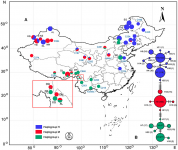acespicoli
Well-known member
Hopefully this thread is a seed that once planted begins to grow,
 www.gramps-project.org
www.gramps-project.org
with community love and support and blessing may it grow into a large tree!
Hopefully its branches reach around the globe to every small village and tribe.
To promote biodiversity and preservation not greed but giving.
Protect the planet and people from corporate greed, may the corporations
always remember that there are people at the heart of every corporation.
More to the point
Genetic preservation its been said we need thousands of plants to maintain.
In this thread im going to suggest whats feasible for us to all do our part.
If you try and preserve a Cannabis landrace with less than 1,000 females from seed and 1,000 males from seed you will lose genes every reproduction that is not real preservation.
Some think the work can be staggered and only 100 reproduced each crop, for 10 consecutive years, but that is not how genetics work you need all 1,000 females and 1,000 males freely pollinating each other, reproduced at the same time in the same location to preserve a landrace and avoid gene loss. Cannabis is a Dioecious, Heterozygous, Obligate Outcrosser, that is why 1,000 males and 1,000 females from seed are required for preservation to keep all the genepool intact for a given landrace.-SamS
Statistical genetic considerations for maintaining germ plasm collections
J. Crossa , C. M. Hernandez , P. Bretting , S. A. Eberhart , S. Taba
Theor Appl Genet (1993) 86:673-678
DOI: 10.1007/BF00222655
Methodologies for estimating the sample size required for genetic conservation of outbreeding crops.
Crossa, J.
Theoretical and Applied Genetics, 77(2). (1989).
doi:10.1007/bf00266180
Cannabis is a
Dioecious, Obligate Outcrosser,
Cannabis sativa L. (hemp, marijuana) produces male and female inflorescences on different plants (dioecious) and therefore the plants are obligatory out-crossers.
Heterozygous,
having two different alleles of a particular gene or genes.
"the genetic study showed two heterozygous variants"
Have questions???
Statistical genetic considerations for maintaining germ plasm collections
J. Crossa , C. M. Hernandez , P. Bretting , S. A. Eberhart , S. Taba
Theor Appl Genet (1993) 86:673-678
DOI: 10.1007/BF00222655
Theor Appl Genet
doi: 10.1007/BF00222655.
Affiliations
Methodologies for estimating the sample size required for genetic conservation of outbreeding crops.
Crossa, J.
Theoretical and Applied Genetics, 77(2). (1989).
doi:10.1007/bf00266180




In my own situation for example im going to try to preserve a
"indica" and a "sativa" these terms used loosely
for this project im going to look a effect, leaf shape and latitude of origin
for the sativa im going to pick a sativa from a equatorial sativa (?)
maybe Kerala open to suggestions, please post below
for the indica im going to pick a indica type from the snow Himalayas (?)
maybe siberia im open to suggestions,
please post below maybe include a specimen photo
Additionally im looking to aquire 20-40 seeds for a strain
100-200 seeds for genetic preservation
(if a few of us keep a genetic preservation line we could as a collective hold 1000s of seeds)
Also this will aid in personal breeding projects specifically im looking for
plant structure
bud structure
calyx to leaf ratio
maturity time
effect / duration
terpene content
potency
vigor
unique mutations
if you have anything to ask add share here, only good vibes please !
let it grow!

Updated below lines 8.2.2023 Aug

 www.frontiersin.org
www.frontiersin.org
Updates & Thread Quick Links

 en.wikipedia.org
en.wikipedia.org
#356
The existence of a single locus determining the chem-
otype, with at least two alleles, gives a clear genetic
meaning to the tripartite distribution of the chemotypes LITERATURE CITED
within populations, as observed by several authors when Becu, D. M. S., H. D. Mastebroek and H. J. P. Marvin, 1998 Breed-CBD vs. THC content plots are considered (Fournier ing for root knot nematode resistance in hemp. Proceedings of
and Paris 1979; Fournier 1981; de Meijer et al. 1992). Bast Fibrous Plants Today and Tomorrow, St. Petersburg, Russia,
p. 149.
Leaf Morphology - IC Herbarium
Leaf Morphology To catalog is it necessary to use same light sources and are there other environmental plasticity factors to leaf morphology? Regardless we could start to collect some examples with graph paper or measurements? Plants 2023, 12(20), 3646; https://doi.org/10.3390/plants12203646...
www.icmag.com
Cannabis Seed Morphology
Please share some of your seed pics here as well A multivariate analysis of morphological divergence of “seeds” (achenes) among ruderal, fibre, oilseed, dioecious/monoecious and marijuana variants of Cannabis sativa L. https://doi.org/10.1248/yakushi.130.237
www.icmag.com
Features - Gramps
with community love and support and blessing may it grow into a large tree!
Hopefully its branches reach around the globe to every small village and tribe.
To promote biodiversity and preservation not greed but giving.
Protect the planet and people from corporate greed, may the corporations
always remember that there are people at the heart of every corporation.
More to the point
Genetic preservation its been said we need thousands of plants to maintain.
In this thread im going to suggest whats feasible for us to all do our part.
If you try and preserve a Cannabis landrace with less than 1,000 females from seed and 1,000 males from seed you will lose genes every reproduction that is not real preservation.
Some think the work can be staggered and only 100 reproduced each crop, for 10 consecutive years, but that is not how genetics work you need all 1,000 females and 1,000 males freely pollinating each other, reproduced at the same time in the same location to preserve a landrace and avoid gene loss. Cannabis is a Dioecious, Heterozygous, Obligate Outcrosser, that is why 1,000 males and 1,000 females from seed are required for preservation to keep all the genepool intact for a given landrace.-SamS
Statistical genetic considerations for maintaining germ plasm collections
J. Crossa , C. M. Hernandez , P. Bretting , S. A. Eberhart , S. Taba
Theor Appl Genet (1993) 86:673-678
DOI: 10.1007/BF00222655
Methodologies for estimating the sample size required for genetic conservation of outbreeding crops.
Crossa, J.
Theoretical and Applied Genetics, 77(2). (1989).
doi:10.1007/bf00266180
Cannabis is a
Dioecious, Obligate Outcrosser,
Cannabis sativa L. (hemp, marijuana) produces male and female inflorescences on different plants (dioecious) and therefore the plants are obligatory out-crossers.
Heterozygous,
having two different alleles of a particular gene or genes.
"the genetic study showed two heterozygous variants"
Have questions???
Statistical genetic considerations for maintaining germ plasm collections
J. Crossa , C. M. Hernandez , P. Bretting , S. A. Eberhart , S. Taba
Theor Appl Genet (1993) 86:673-678
DOI: 10.1007/BF00222655
Theor Appl Genet
doi: 10.1007/BF00222655.
Statistical genetic considerations for maintaining germ plasm collections
J Crossa 1 , C M Hernandez, P Bretting, S A Eberhart, S TabaAffiliations
- PMID: 24193775
- DOI: 10.1007/BF00222655
Abstract
One objective of the regeneration of genetic populations is to maintain at least one copy of each allele present in the original population. Genetic diversity within populations depends on the number and frequency of alleles across all loci. The objectives of this study on outbreeding crops are: (1) to use probability models to determine optimal sample sizes for the regeneration for a number of alleles at independent loci; and (2) to examine theoretical considerations in choosing core subsets of a collection. If we assume that k-1 alleles occur at an identical low frequency of p0 and that the k(th) allele occurs at a frequency of 1-[(k-1)p0], for loci with two, three, or four alleles, each with a p0 of 0.05, 89-110 additional individuals are required if at least one allele at each of 10 loci is to be retained with a 90% probability; if 100 loci are involved, 134-155 individuals are required. For two, three, or four alleles, when p0 is 0.03 at each of 10 loci, the sample size required to include at least one of the alleles from each class in each locus is 150-186 individuals; if 100 loci are involved, 75 additional individuals are required. Sample sizes of 160-210 plants are required to capture alleles at frequencies of 0.05 or higher in each of 150 loci, with a 90-95% probability. For rare alleles widespread throughout the collection, most alleles with frequencies of 0.03 and 0.05 per locus will be included in a core subset of 25-100 accessions.Methodologies for estimating the sample size required for genetic conservation of outbreeding crops.
Crossa, J.
Theoretical and Applied Genetics, 77(2). (1989).
doi:10.1007/bf00266180
Summary
The main purpose of germplasm banks is to preserve the genetic variability existing in crop species. The effectiveness of the regeneration of collections stored in gene banks is affected by factors such as sample size, random genetic drift, and seed viability. The objective of this paper is to review probability models and population genetics theory to determine the choice of sample size used for seed regeneration. A number of conclusions can be drawn from the results. First, the size of the sample depends largely on the frequency of the least common allele or genotype. Genotypes or alleles occurring at frequencies of more than 10% can be preserved with a sample size of 40 individuals. A sample size of 100 individuals will preserve genotypes (alleles) that occur at frequencies of 5%. If the frequency of rare genotypes (alleles) drops below 5%, larger sample sizes are required. A second conclusion is that for two, three, and four alleles per locus the sample size required to include a copy of each allele depends more on the frequency of the rare allele or alleles than on the number. Samples of 300 to 400 are required to preserve alleles that are present at a frequency of 1%. Third, if seed is bulked, the expected number of parents involved in any sample drawn from the bulk will be less than the number of parents included in the bulk. Fourth, to maintain a rate of breeding (F) of 1 %, the effective population size (N e) should be at least 150 for three alleles, and 300 for four alleles. Fifth, equalizing the reproductive output of each family to two progeny doubles the effective size of the population. Based on the results presented here, a practical option is considered for regenerating maize seed in a program constrained by limited funds.In my own situation for example im going to try to preserve a
"indica" and a "sativa" these terms used loosely
for this project im going to look a effect, leaf shape and latitude of origin
for the sativa im going to pick a sativa from a equatorial sativa (?)
maybe Kerala open to suggestions, please post below
for the indica im going to pick a indica type from the snow Himalayas (?)
maybe siberia im open to suggestions,
please post below maybe include a specimen photo
Additionally im looking to aquire 20-40 seeds for a strain
100-200 seeds for genetic preservation
(if a few of us keep a genetic preservation line we could as a collective hold 1000s of seeds)
Also this will aid in personal breeding projects specifically im looking for
plant structure
bud structure
calyx to leaf ratio
maturity time
effect / duration
terpene content
potency
vigor
unique mutations
if you have anything to ask add share here, only good vibes please !
let it grow!


Updated below lines 8.2.2023 Aug

Cannabis Genomics, Breeding and Production
The legal status of cannabis is changing in many countries, but because it was prohibited for the past century, research is lacking on basic aspects of this crop species. In order to support cannabis production, for the medicinal and recreational markets, scientific research needs to expand in...
Updates & Thread Quick Links

Glossary of leaf morphology - Wikipedia
#356
The existence of a single locus determining the chem-
otype, with at least two alleles, gives a clear genetic
meaning to the tripartite distribution of the chemotypes LITERATURE CITED
within populations, as observed by several authors when Becu, D. M. S., H. D. Mastebroek and H. J. P. Marvin, 1998 Breed-CBD vs. THC content plots are considered (Fournier ing for root knot nematode resistance in hemp. Proceedings of
and Paris 1979; Fournier 1981; de Meijer et al. 1992). Bast Fibrous Plants Today and Tomorrow, St. Petersburg, Russia,
p. 149.
Attachments
Last edited:




 aww love this great description nice photos too ! thank you for taking the time to share it !
aww love this great description nice photos too ! thank you for taking the time to share it !



